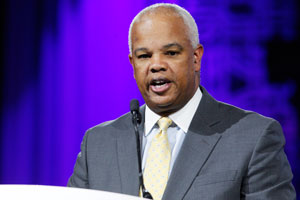Senior Reporter
Darling Says Final Rule is Near for Driver Training, Drug and Alcohol Clearinghouse

The driver training rule is an important step toward ensuring that all drivers are qualified and that training schools have the appropriate requirements in place, FMCSA Administrator Scott Darling told attendees at American Trucking Associations’ 2016 Management Conference & Exhibition.
Darling said the clearinghouse rule will help ensure that truck drivers remain free of drugs and alcohol. “The rulemaking goes a long way towards that goal,” Darling said Oct. 3.
FMCSA published a proposed version of the entry level driver rule in March after going through a negotiated rulemaking process, including major industry stakeholders such as American Trucking Associations, the Owner-Operator Independent Drivers Association, driver training schools and safety advocacy groups.
The proposed drug-and-alcohol clearinghouse rule, published in February 2014, would require motor carriers and other medical personnel to “report verified positive, adulterated and substituted drug test results, positive alcohol test results, test refusals, negative return-to-duty test results and information on follow-up testing.” The proposed rule also called for employers to search the clearinghouse for positive drug-and-alcohol test results, and refusals to test, annually for current employees and as part of the pre-employment process for prospective employees.
Darling also encouraged truckers to comment on a proposed rule requiring that speed limiters be installed on all new trucks. The agency currently is weighing whether to require that heavy trucks be speed limited to 60, 65 or 68 miles per hour.
Darling said his agency has reached out to partner with stakeholders who have a direct role in highway safety.
“We have reached out to partners in every segment of the industry. Whether you’re a big carrier, an ELD or truck manufacturer, shipper, broker, or software developer, you have a direct role to play in highway safety,” Darling said. “We push safety partnerships because the stakes are high.”
Darling told truck executives that he was “disheartened” to learn of an increase in truck-involved fatalities in 2015.
He was referring to news in August that there were 4,067 fatalities in crashes involving large trucks in 2015, 4.1% more than in 2014, the highest since 2008, according to DOT’s National Highway Traffic Safety Administration data.
“Those are not just mere numbers on paper, but each of them represents a human life lost on the highway,” Darling said. “We must do better.”



